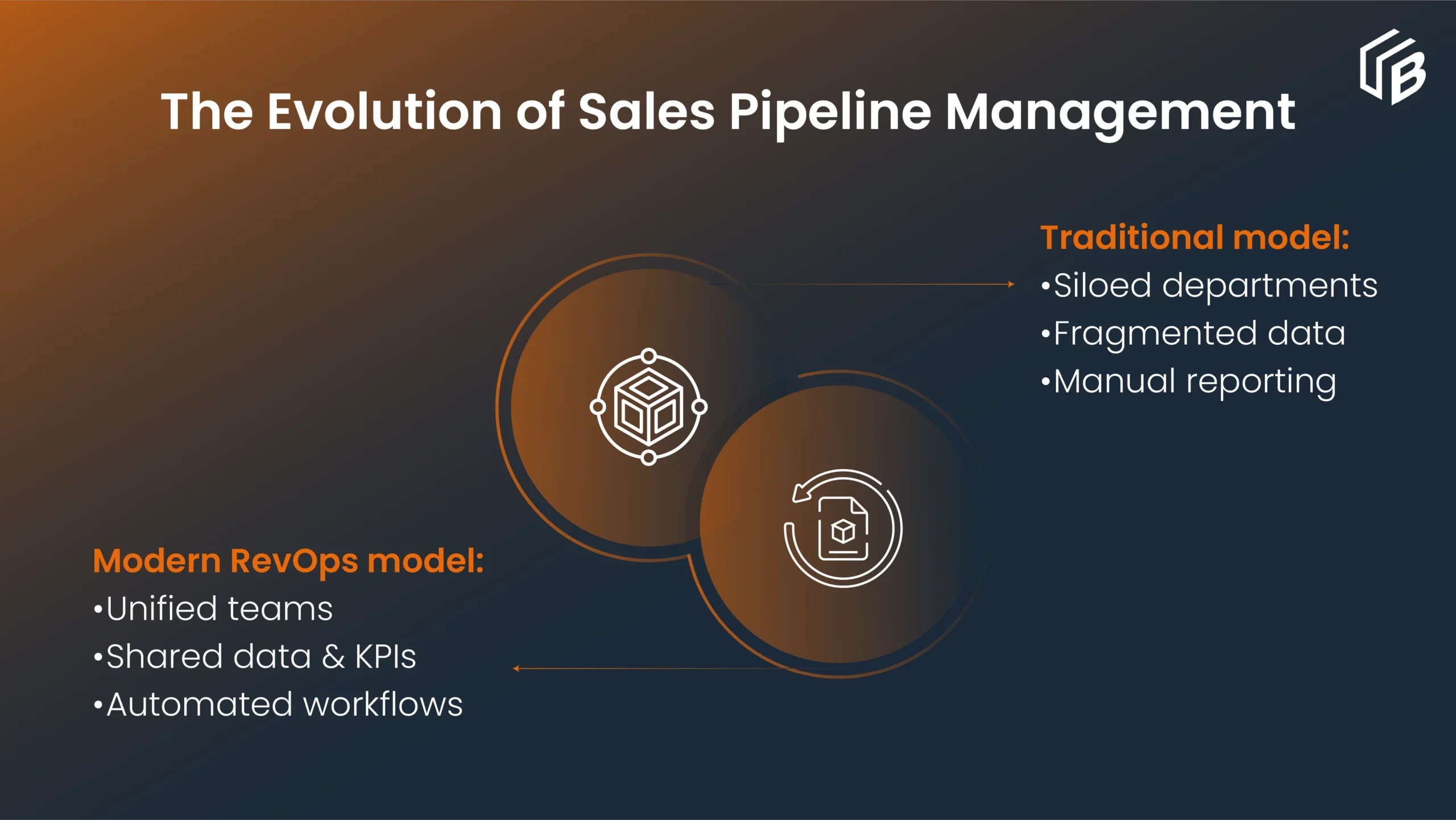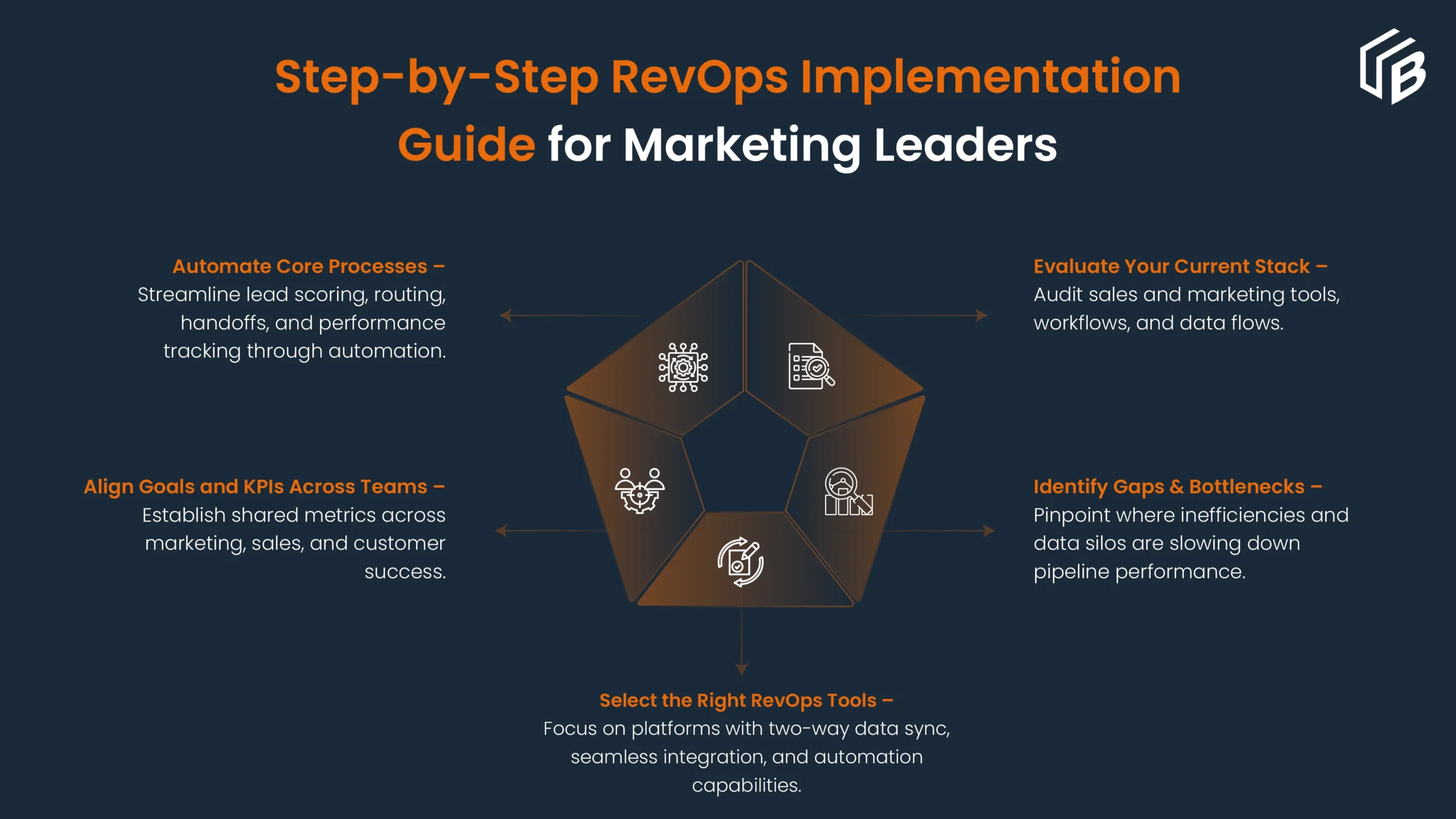
Marketing leaders today are under increasing pressure to drive revenue growth amid increasingly complex and nonlinear sales pipelines. At the same time, they must outmaneuver competitors by delivering greater speed, accuracy, and relevance across every touchpoint of the buyer journey.
The buyer’s journey has become increasingly non-linear, making it harder for marketing, sales, and customer success teams to stay aligned. With data still fragmented across systems and handoffs between teams often breaking down, traditional pipeline management approaches are falling short. In response, Revenue Operations—commonly known as RevOps—is emerging as a strategic solution to unify processes, systems, and data across the entire revenue engine.
RevOps, particularly when combined with automation, offers a unified framework for overseeing and optimizing pipeline management in sales. This approach merges sales operations, marketing, and customer success into a single strategic unit. Through automation, it enhances consistency, efficiency, and strategic alignment while driving long-term growth. RevOps automation is fast becoming an essential strategy for marketing leaders aiming to impact sales revenue beyond basic lead generation.
Why RevOps Automation Should Be a Strategic Priority for B2B Marketers
Most B2B organizations face the same chronic challenge and that is fragmented processes. Marketing, sales, and customer success often operate in silos, each using different tools, tracking different metrics, and working toward goals that don’t align. This disconnection results in delayed insights, poor lead handoffs, and inconsistent customer experiences—problems that weaken sales pipeline management and stall growth.
Instead of treating each department as a standalone entity, RevOps unifies them through shared data, platforms, and KPIs across the revenue lifecycle. This integration allows for seamless communication, aligned workflows, and data-driven decision-making across the full sales funnel. As Salesforce puts it, RevOps is a B2B function that integrates systems and strategies to enhance operational performance at every customer touchpoint.
Organizations adopting RevOps best practices see measurable gains in operational efficiency and team accountability. Transparency across departments leads to faster execution, greater agility, and better forecasting—outcomes that marketing leaders increasingly need to justify their contributions.

Fragmented Ops vs. a Unified Revenue Engine
Historically, marketing, sales, and customer success teams operated with distinct tools and independent objectives. For example, marketing would focus on MQLs and campaign engagement metrics, while sales pursued SQLs using a separate CRM system. This fragmented approach made managing sales pipeline performance difficult, and often led to delays, inefficiencies, and missed revenue targets.
RevOps solves that foundational problem by providing a cohesive structure where systems and goals are unified. By using a shared RevOps framework, organizations benefit from aligned processes, better visibility, and clearer accountability. This structural shift enables teams to operate with greater precision—accelerating pipeline velocity and improving end-to-end collaboration.
The shift from isolated departmental strategies to a consolidated RevOps strategy has already begun, and companies that act early position themselves to scale faster and more effectively.
RevOps Automation Empowers Marketers to Drive Pipeline Performance
Marketing’s contribution to B2B sales pipeline management is now more visible and more scrutinized—than ever before. According to a 2023 Demand Gen Report, marketers using unified RevOps data saw a 27% improvement in campaign-to-revenue attribution. This level of visibility supports smarter campaign optimization and enables continuous performance tuning.
RevOps automation provides marketers with tools that not only track engagement but influence pipeline velocity, conversion rates, and budget allocation. It equips marketing departments with real-time data to guide strategic decisions—helping them prove and improve their impact on sales revenue.
In boardrooms and budget discussions, demonstrating marketing’s impact is critical. Marketing leaders are expected to articulate how their strategies contribute to pipeline integrity and accelerate revenue outcomes. A robust RevOps tech stack enables this by providing unified visibility, reliable data, and streamlined reporting by eliminating the need for fragmented systems and manual workarounds.
Common Pipeline Challenges in Modern B2B Sales
In many organizations, departmental systems confine data within separate platforms. This creates major visibility gaps, especially for marketing. Once a lead is handed off to sales, marketing often loses track of its status, interactions, or conversion barriers. One of the top challenges facing B2B marketers is a lack of integration across systems—making it nearly impossible to assess lead progression or delay points accurately.
These breakdowns have measurable consequences. When leads are not acted on promptly, they go cold. In many cases, qualified marketing-generated leads expire before sales can follow up. The primary cause? Poor handoffs, driven by a lack of consistent lead qualification criteria and shared workflows.
Even pipeline reviews are impacted. Manual reporting processes lead to reactive decision-making and delayed performance insights. B2B sales and marketing teams often lose alignment due to fragmented reporting and disconnected tech ecosystems—ultimately causing delays and missed targets.
How RevOps Automation Transforms Pipeline Management
Marketing managers now have the opportunity to solve these challenges through automation. By adopting RevOps automation, teams can centralize CRM data, campaign metrics, and engagement insights. This unified view offers real-time visibility into pipeline health, enabling faster adjustments and smarter forecasting at every stage of the sales funnel.
Automation supports predictive models based on historical data, allowing marketers to anticipate outcomes and allocate resources accordingly. Rather than reacting to end-of-quarter reports, teams can proactively correct bottlenecks and manage velocity throughout the pipeline.
Automated lead management is also redefining how marketing teams handle prioritization. Intelligent platforms now perform lead scoring, segmentation, and routing based on behavior, demographics, and campaign interaction. Leads identified as high-potential are assigned quickly, minimizing delay and improving conversion chances. This process ensures RevOps strategies are applied consistently across the funnel, reducing response time and improving handoff efficiency.
For a marketing ops lead managing, lead scoring and CRM integration daily, RevOps transforms organizational complexity into strategic clarity, with fewer meetings and better reporting. Through RevOps processes, teams can analyze patterns, measure pipeline velocity, and model future outcomes. These insights drive accurate budget planning and enable targeted campaign design aligned with sales goals. The result is a smarter, faster, and more accountable sales pipeline management approach.
Three Ways Automation Supercharges Pipeline Growth
1. Accelerates Speed-to-Lead
Speed matters in a competitive market. A study by Deloitte, cited in The Wall Street Journal, found that B2B buyers now demand highly responsive, personalized engagement. Manual workflows often fail to deliver on this expectation. RevOps automation changes that. Automated response systems allow both marketing and sales teams to reduce lead response times from hours—or even days—to minutes. These systems improve pipeline responsiveness and increase qualified engagement rates, giving companies a crucial edge.
2. Enables Scalable Growth
Without automation, scaling revenue functions typically requires expanding teams—a solution that isn’t always financially viable. RevOps tools allow marketing departments to scale output and effectiveness without adding headcount. This efficiency is critical for lean teams operating in high-growth environments. A well-integrated RevOps tech stack multiplies output, enabling enterprise-level impact through intelligent automation and synchronized efforts.
3. Drives Lasting Team Alignment
Many marketing and sales teams rely on meetings and planning sessions to align. These can work—but they’re slow and inconsistent. With shared dashboards and automated alerts built into their daily systems, RevOps teams stay on the same page without relying on ad hoc collaboration. Daily alignment becomes procedural, embedded in the tech itself. Over time, this fosters a consistent rhythm of execution that’s harder to break.
How to Get Started with RevOps Automation
Getting started with RevOps doesn’t require a total overhaul. Marketers are often the first to identify inefficiencies in pipeline performance—and the first to benefit from automation-driven insight. Implementation doesn’t require reinventing your department. It begins with reevaluating current systems and identifying tools that can unify data across teams.
The most effective RevOps strategy avoids the trap of software overload. Instead of pursuing the most feature-rich options, teams should focus on systems that offer two-way sync, data visibility, and functional alignment. CRM, MAP, and BI tools that integrate easily provide the foundation for scalable RevOps automation.

Key performance indicators must also evolve. Beyond MQL volume, marketers should measure MQL-to-SQL conversions, time-to-lead-response, and campaign-driven revenue. These metrics align directly with executive priorities and validate decisions on tech investments and pipeline strategy. By doing so, marketing can lead the charge in managing sales pipeline efficiency through automation and insight.
UnboundB2B’s Role in the RevOps Journey
UnboundB2B plays a strategic role in helping B2B marketing and revenue teams operationalize RevOps with precision, speed, and scalability. By aligning marketing, sales, and customer success around a unified revenue engine, UnboundB2B empowers organizations to move beyond siloed tactics and build cohesive, full-funnel strategies grounded in measurable business impact.
Leveraging its proprietary BrandGen framework and a comprehensive suite of services: including intent-driven content syndication, SDR-as-a-Service, and account-based marketing. UnboundB2B equips teams to accelerate pipeline velocity, improve lead-to-revenue conversion, and maintain alignment with RevOps best practices. Their data-centric approach, powered by AI and advanced buyer intent analytics, ensures that every engagement is targeted, timely, and tied to clear outcomes.
Whether it’s building brand authority, expanding reach, or driving qualified demand, UnboundB2B enables clients to implement RevOps strategies that are not only integrated but also sustainably anchored in transparent workflows, outcome-based metrics, and repeatable processes that support long-term growth.
Final Thoughts
RevOps is no longer an emerging concept. It’s a necessary shift.
Marketing managers face a rapidly changing reality shaped by three converging trends:
First, rising buyer expectations. Manual systems can’t keep up with high-volume personalization demands.
Second, budget constraints. Marketers must now prove revenue impact with greater precision than ever before—and automation supplies the data to do so.
Third, accessible technology. The tools required to implement RevOps automation are no longer limited to large enterprises. Cost-effective platforms are available now, enabling small and mid-sized teams to compete with agility.
For marketing teams seeking real transformation, the opportunity is immediate. Implementing RevOps today isn’t just about catching up—it’s about moving ahead. As competitors continue aligning their spreadsheets, your integrated tech and workflows can drive forward with speed, insight, and impact.
The value is measurable. The systems are ready. How to manage your sales pipeline is no longer a mystery—it’s a RevOps decision.
Our blog
Latest blog posts
Tool and strategies modern teams need to help their companies grow.

Discover six hybrid B2B marketing event formats that drive real pipeline growth, enha...

Struggling to convert your SQLs? Learn the common mistake B2B companies make and opti...

Turn your owned channels into a precision account-based marketing (ABM) engine that w...






